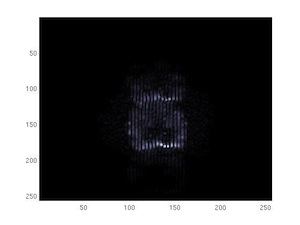|
Magnetic
Resonance -
Technology
Information
Portal |
Welcome to MRI Technology • • |
|
|
 | Info
Sheets |
| | | | | | | | | | | | | | | | | | | | | | | | |
 | Out-
side |
| | | | |
|
| | | | | |
| Result: Searchterm 'signal'
found in 52 messages |
| Result Pages: 1 2 3 [4] 5 6 7 8 9 10 11 |
More Results:  Database (369) Database (369)  News Service (50) News Service (50)  Resources (8) Resources (8) |
|
|
Steven Ford
Tue. 31 Jan.12,
08:19
[Reply (1 of 2) to:
'RF shimming'
started by: 'Reader Mail'
on Thu. 1 Oct.09]

 Category: Category:
Basics and Physics
|
| RF shimming |
For Magnetic fields, the overall field is adjusted to push it up a little bit in one spot and push it down a little bit in another area. The goal is to create a field that's perfectly homogenous.
The RF field created by the transmit coil likewise must be as homogenous as possible, so that the flip angle is constant throughout the imaging volume. In the past, designers have solved this problem by building coils such as the 'birdcage' style that would create a very even amount of energy inside. This is one reason why the transmit coils tend to be large.
With the advent of 3 Tesla and stronger magnets, the RF resonant frequency also rises. RF energy absorbed in the patient rises with the higher frequencies also, and another problem raises its head: it's a lot harder to make a very homogenous RF field. Even if you are scanning phantoms, the inside tends to be subject to different energy than the edges.
But in the human body, there are all sorts of irregular lumps and bumps that absorb RF differently, further complicating matters.
Now, on modern scanners it's possible to perform a magnetic field shim with the patient actually in the magnet in order to compensate for minute changes in the magnet from one exam to another. For super-high field magnets, an RF shim is also a handy thing to do.
If you have a Multi element RF transmit coil (regular phased array coils are just for receiving) you can run a program which selectively turns up the power in some elements so that the overall signal received is maximized. That's an RF shim.
Steven Ford
Professional Imaging Services, Inc.
|
|  View the whole thread View the whole thread | | |
Anna Lena Golay
Wed. 25 Jan.12,
20:59
[Reply (3 of 7) to:
'Imaging optic neuritis'
started by: 'Karen Lesley'
on Wed. 18 Jan.12]

 Category: Category:
General
|
| Imaging optic neuritis |
A 2-3 mm STIR sequence through the optic nerves may show the characteristic high-signal intensity of optic neuritis. Gadolinium enhanced T1-weighted fat-saturated (to suppress the bright signal of the orbital fat tissue) images of the orbits show the inflammation of the optic nerve. White matter lesions, which denote a higher risk of developing MS, are typical imaged with FLAIR and T2-weighted images (hyperintense lesions), or show enhancement of T1-weighted images postcontrast.
|
|  View the whole thread View the whole thread | | |
Adana Osco Barras
Tue. 3 Jan.12,
21:09
[Reply (1 of 2) to:
'Hyperintense blood vessels in SE'
started by: 'Peruvumba Jayakumar'
on Thu. 29 Dec.11]

 Category: Category:
Sequences and Imaging Parameters
|
| Hyperintense blood vessels in SE |
Prolonged T1 relaxation times, decreased T1 tissue contrast, and increased susceptibility rnare typical effects at high field MRI.rnDue to the longer T1 times at 3T, the signal rnintensity inside the vessels is preserved even in smaller vessels. Try TR 700, TE 10.rnInversion recovery sequences are very well suited for optimal gray to white matter contrast, but enhancement after administration of gadolinium may not be visible.
|
|  View the whole thread View the whole thread | | |
Reader Mail
Tue. 26 Jul.11,
14:05
[Start of:
'MR750: ASSET Artifact or 32 Channel coil?'
1 Reply]

 Category: Category:
Funktional MRI
|
| MR750: ASSET Artifact or 32 Channel coil? |
Hi,
We are performing fMRI on a GE MR750 Discovery.
As you can see we get artifacts when performing DTI and fMRI.
It looks like herringbones or spikes artifacts. But it appears only at the very top slices where there is generally no more brain.
One possible explanation is that ASSET will produce the artifact where there is no signal.
Another explanation would be that some element of the 32 channel coil is going mad.
Has anybody experienced the same artifact?
Thank you.
 DTI artifact DTI artifact


|
|  View the whole thread View the whole thread |  Reply to this thread Reply to this thread
(login or register first) | |
Lirong TAN
Thu. 23 Jun.11,
02:44
[Start of:
'fMRI frequency range'
0 Reply]

 Category: Category:
Funktional MRI
|
| fMRI frequency range |
Hi,
I am trying to decompose the original fMRI time series into several components with different frequency ranges. I use the MODWT wavelet analysis. To obtain the components' frequencies, I need to know the frequency range of the original fMRI signal. Is it 0-1/TR?
Thanks a lot.
Lirong
|
| |  Reply to this thread Reply to this thread
(login or register first) |
| |
| | Result Pages : 1 2 3 [4] 5 6 7 8 9 10 11 | |
|
| |
 | Look
Ups |
| |
|
MR-TIP.com uses cookies! By browsing MR-TIP.com, you agree to our use of cookies. | | | [last update: 2024-02-26 03:41:00] |
|
|